The Alhambra is a large, walled complex of buildings that commands a hilltop location above the city of Granada. It was built over over several centuries by rulers such as Ismail I, Yusef I, and Muhammad V, caliphs of the Nazarid Dynasty. Though their power was waning in al-Andalus, they sought to prove their invincibility through the forbidding and seeminingly unassailable position of the Alhambra. Its perch allowed it to serve as both a retreat for the rulers but also an obvious military function to defend the city from invaders. Surrounded by thick, double walls separated by an open space to move troops and isolate invaders, it proved a safe haven for the population. In the foreground are some of the exterior defensive walls and the watch towers that surround the site, protecting the palaces, mosques and other buildings within. In the far distance can be seen the summer estate and gardens, called the Generalife Gardens (from the Arabic, yannat-al-arif, or 'gardens of lofty paradise'). It was to this estate, surrounded by terraces gardens, flowing with water and fountains, and rich with flowering, aromatic tress and shrubs, that the Nazarid rulers would retreat. Paradise is often described in Islam as a place of flowering trees and flowing waters, and these gardens are filled with both. Water to irrigate the landscaping and to fill the many reflecting pools and fountains had to be pumped up the steep hill on which the Alhambra sits by in ingenious system of water wheels. This 'oasis' provided a welcome respite from the palace intrigues of the Alhambra. The gardens are beautifully restored, and still provide the traveler with a welcome spot to cool off, breathe the scented air, and rest one's feet.
In 1492, Granada and its impregnable Alhambra would be the last bastion of Islam to fall to the Catholic Monarchs when the last Caliph of the Nazarid Dynasty in al-Andalus, Boabdil, surrendered in disgrace to the Catholic Monarchs, Ferdinand and Isabella. He was alleged to have wept as he surrendered his beloved city. His bitter mother is said to have dismissed Boabdil with 'Do not weep like a woman if you cannot defend like a man." Ferdinand and Isabella are of course known as the monarchs who sent Cristobal Colón (Christopher Columbus) on his eventful journey across the Atlantic in search of India.

Exterior walls and defensive battlements with the Generalife Gardens
and summer palace in the distance, Alhambra, Granada, Spain 1350 CE


